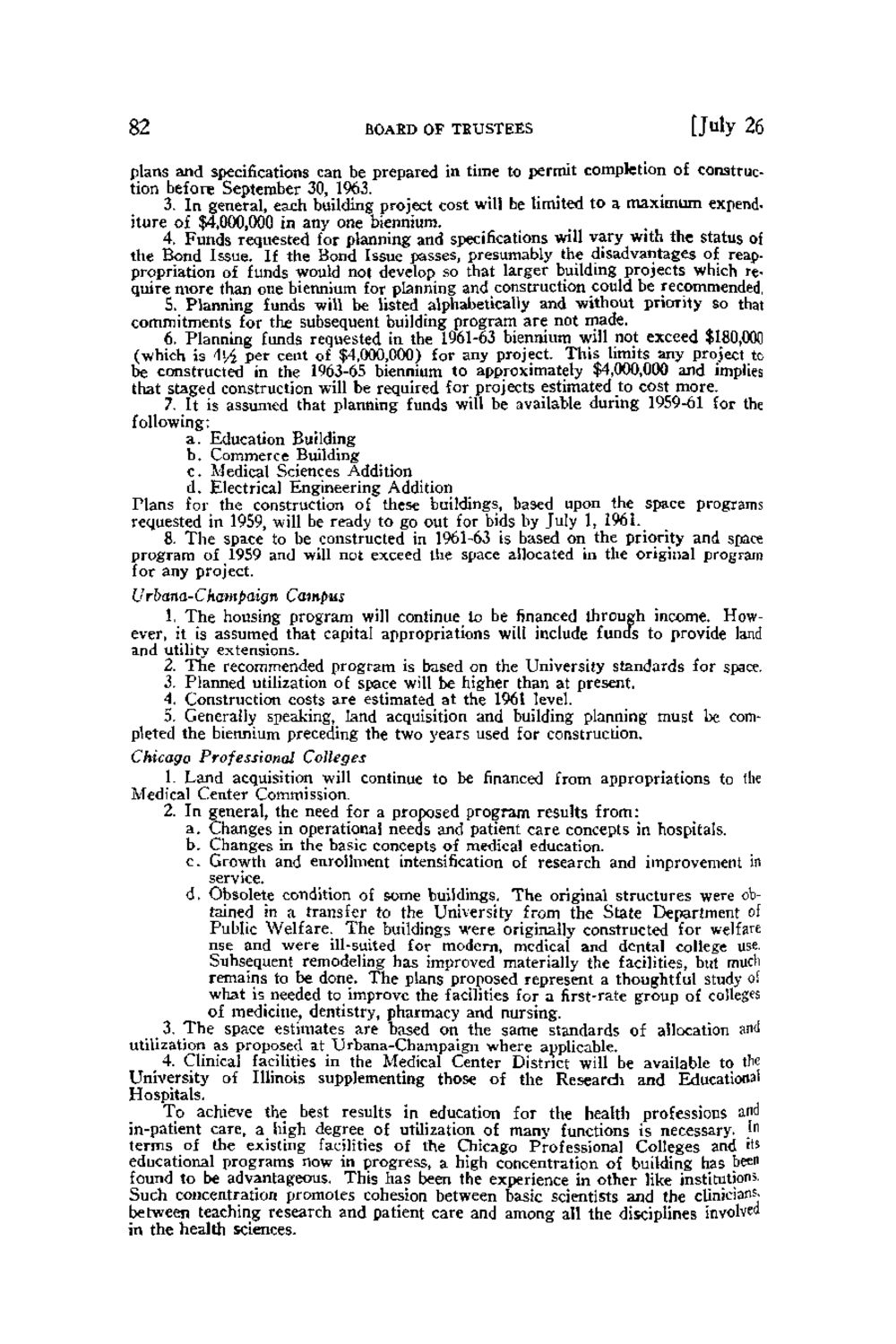| |
| |
Caption: Board of Trustees Minutes - 1962
This is a reduced-resolution page image for fast online browsing.

EXTRACTED TEXT FROM PAGE:
82 BOAKD OF TEUSTEES [July 26 plans and specifications can be prepared in time to permit completion of construction before September 30, 1963. 3. In general, each building project cost will be limited to a maximum expenditure of $4,000,000 in any one biennium. 4. Funds requested for planning and specifications will vary with the status of the Bond Issue. If the Bond Issue passes, presumably the disadvantages of reappropriation of funds would not develop so that larger building projects which require more than one biennium for planning and construction could be recommended, 5. Planning funds will be listed alphabetically and without priority so that commitments for the subsequent building program are not made. 6. Planning funds requested in the 1961-63 biennium will not exceed $180,000 (which is 1'/i per cent of HO0O.0O0) for any project. This limits any project to be constructed in the 1963-65 biennium to approximately $4,000,000 and implies that staged construction will be required for projects estimated to cost more. 7. It is assumed that planning funds will be available during 1959-61 for the following: a. Education Building b . Commerce Building c . Medical Sciences Addition d. Electrical Engineering Addition Plans for the construction o£ these buildings, based upon the space programs requested in 1959, will be ready to go out for bids by July 1, 1961. 8. The space to be constructed in 1961-63 is based on the priority and space program of 1959 and will not exceed the space allocated in the original program for any project. U rbana-Chatn paign Campus 1. The housing program will continue lo be financed through income. However, it is assumed that capital appropriations wili include funds to provide land and utility extensions. 2. The recommended program is based on the University standards for space. 3. Planned utilization of space will be higher than at present. 4. Construction costs are estimated at the 1961 level. 5. Generally speaking, land acquisition and building planning must be completed the biennium preceding the two years used for construction, Chicago Professional Colleges 1. Land acquisition will continue to be financed from appropriations to the Medical Center Commission. 2. In general, the need for a proposed program results from: a. Changes in operational needs and patient care concepts in hospitals. b . Changes in the basic concepts of medical education. c . Growth and enrollment intensification of research and improvement in service. d. Obsolete condition of some buildings. The original structures were obtained in a transfer to the University from the State Department of Public Welfare. The buildings were originally constructed for welfare nse and were ill-suited for modern, medical and dental college use. Suhsequent remodeling has improved materially the facilities, but mucli remains to be done. The plans proposed represent a thoughtful study of what is needed to improve the facilities for a first-rate group of colleges of medicine, dentistry, pharmacy and nursing. 3. T h e space estimates are based on the same standards of allocation and utilization as proposed at Tjrbana-Champaign where applicable. _ 4. Clinical facilities in the Medical Center District will be available to trie University of Illinois supplementing those of the Researdi and Educational Hospitals. To achieve the best results in education for the health professions and in-patient care, a high degree of utilization of many functions is necessary. _'n terms of the existing facilities of the Chicago Professional Colleges and its educational programs now in progress, a high concentration of building has been found to be advantageous. This has been the experience in other like institutions. Such concentration promotes cohesion between baste scientists and the clinicians, between teaching research and patient care and among all the disciplines involved in the health sciences.
| |